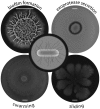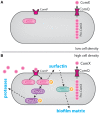Social behaviours by Bacillus subtilis: quorum sensing, kin discrimination and beyond
- PMID: 30218468
- PMCID: PMC6334282
- DOI: 10.1111/mmi.14127
Social behaviours by Bacillus subtilis: quorum sensing, kin discrimination and beyond
Abstract
Here, we review the multiple mechanisms that the Gram-positive bacterium Bacillus subtilis uses to allow it to communicate between cells and establish community structures. The modes of action that are used are highly varied and include routes that sense pheromone levels during quorum sensing and control gene regulation, the intimate coupling of cells via nanotubes to share cytoplasmic contents, and long-range electrical signalling to couple metabolic processes both within and between biofilms. We explore the ability of B. subtilis to detect 'kin' (and 'cheater cells') by looking at the mechanisms used to potentially ensure beneficial sharing (or limit exploitation) of extracellular 'public goods'. Finally, reflecting on the array of methods that a single bacterium has at its disposal to ensure maximal benefit for its progeny, we highlight that a large future challenge will be integrating how these systems interact in mixed-species communities.
© 2018 The Authors. Molecular Microbiology Published by John Wiley & Sons Ltd.
Figures






Similar articles
-
Bacillus subtilis Protects Public Goods by Extending Kin Discrimination to Closely Related Species.mBio. 2017 Jul 5;8(4):e00723-17. doi: 10.1128/mBio.00723-17. mBio. 2017. PMID: 28679746 Free PMC article.
-
Self-sensing in Bacillus subtilis quorum-sensing systems.Nat Microbiol. 2018 Jan;3(1):83-89. doi: 10.1038/s41564-017-0044-z. Epub 2017 Oct 16. Nat Microbiol. 2018. PMID: 29038467 Free PMC article.
-
Identification of a quorum sensing pheromone posttranslationally farnesylated at the internal tryptophan residue from Bacillus subtilis subsp. natto.Biosci Biotechnol Biochem. 2015;79(10):1567-9. doi: 10.1080/09168451.2015.1032884. Epub 2015 Apr 9. Biosci Biotechnol Biochem. 2015. PMID: 25855042
-
A complex path for domestication of B. subtilis sociality.Curr Genet. 2015 Nov;61(4):493-6. doi: 10.1007/s00294-015-0479-9. Epub 2015 Feb 14. Curr Genet. 2015. PMID: 25680358 Review.
-
Environmental factors that shape biofilm formation.Biosci Biotechnol Biochem. 2016;80(1):7-12. doi: 10.1080/09168451.2015.1058701. Epub 2015 Jun 23. Biosci Biotechnol Biochem. 2016. PMID: 26103134 Review.
Cited by
-
Kin Discrimination Modifies Strain Distribution, Spatial Segregation, and Incorporation of Extracellular Matrix Polysaccharide Mutants of Bacillus subtilis Strains into Mixed Floating Biofilms.Appl Environ Microbiol. 2022 Sep 22;88(18):e0087122. doi: 10.1128/aem.00871-22. Epub 2022 Sep 12. Appl Environ Microbiol. 2022. PMID: 36094206 Free PMC article.
-
The Utilization of Bacillus subtilis to Design Environmentally Friendly Living Paints with Anti-Mold Properties.Microorganisms. 2024 Jun 18;12(6):1226. doi: 10.3390/microorganisms12061226. Microorganisms. 2024. PMID: 38930607 Free PMC article.
-
Annulment of Bacterial Antagonism Improves Plant Beneficial Activity of a Bacillus velezensis Consortium.Appl Environ Microbiol. 2022 Apr 26;88(8):e0024022. doi: 10.1128/aem.00240-22. Epub 2022 Apr 5. Appl Environ Microbiol. 2022. PMID: 35380452 Free PMC article.
-
Resolving the conflict between antibiotic production and rapid growth by recognition of peptidoglycan of susceptible competitors.Nat Commun. 2022 Jan 20;13(1):431. doi: 10.1038/s41467-021-27904-2. Nat Commun. 2022. PMID: 35058430 Free PMC article.
-
Kin discrimination drives territorial exclusion during Bacillus subtilis swarming and restrains exploitation of surfactin.ISME J. 2022 Mar;16(3):833-841. doi: 10.1038/s41396-021-01124-4. Epub 2021 Oct 14. ISME J. 2022. PMID: 34650232 Free PMC article.
References
-
- Ansaldi, M. , Marolt, D. , Stebe, T. , Mandic‐Mulec, I. and Dubnau, D. (2002) Specific activation of the Bacillus quorum‐sensing systems by isoprenylated pheromone variants. Molecular Microbiology, 44, 1561–1573. - PubMed
-
- Bai, U. , Mandic‐Mulec, I. and Smith, I. (1993) SinI modulates the activity of SinR, a developmental switch protein of Bacillus subtilis, by protein‐protein interaction. Genes & Development, 7, 139–148. - PubMed
Publication types
MeSH terms
Substances
Grants and funding
- [P4-0116; J4-7637; J4-9302]/Slovenian research agency/International
- P001335/Biotechnology and Biological Sciences Research Council/United Kingdom
- R012415/Biotechnology and Biological Sciences Research Council/United Kingdom
- 1/Biotechnology and Biological Sciences Research Council/United Kingdom
- P4-0116,/Biotechnology and Biological Sciences Research Council/United Kingdom
- J4-7637/Biotechnology and Biological Sciences Research Council/United Kingdom
- P4-0116/Slovenian research agency/International
- J4-7637/Slovenian research agency/International
- J4-9302/Slovenian research agency/International
- BB/P001335/1/Biotechnology and Biological Sciences Research Council/United Kingdom
- BB/R012415/1/Biotechnology and Biological Sciences Research Council/United Kingdom
LinkOut - more resources
Full Text Sources
Other Literature Sources

